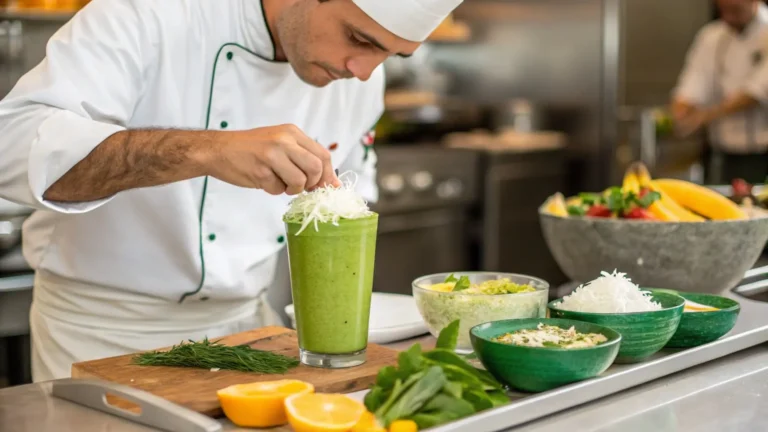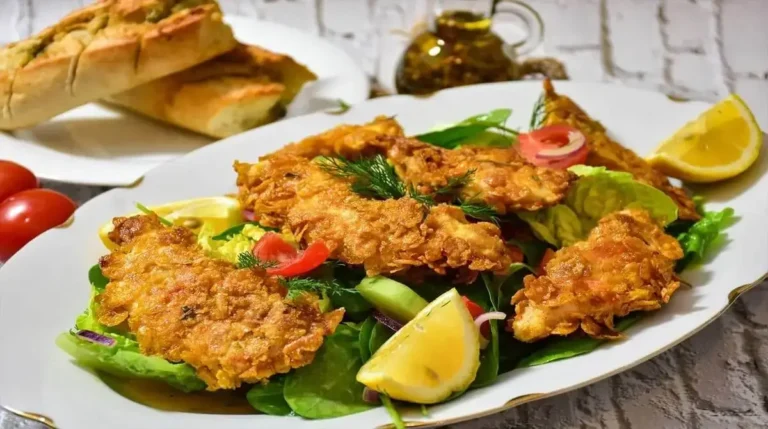The Ultimate Guide to Thrifty & Delicious Budget Friendly Diet Meals
Eating healthy often feels like it comes with a hefty price tag. We see aisles of fresh, organic produce and specialty diet foods and think, “My wallet can’t handle that!” But what if I told you that delicious, nutritious eating doesn’t have to drain your bank account? Welcome to the world of budget friendly diet meals! It’s all about smart choices, clever cooking, and knowing how to make the most of every ingredient. You absolutely can nourish your body with wholesome foods without emptying your savings. It’s not just possible; it’s easier than you might think. This guide will show you how to master the art of eating well on a budget, proving that healthy and affordable can go hand in hand. Following dietary guidelines like those from ChooseMyPlate can help you achieve a healthy and balanced diet, even on a budget.
Table of Contents
Why Choose Budget Friendly Diet Meals?
Choosing to focus on budget friendly diet cooking is a smart move for so many reasons. It’s not just about saving money; it’s about taking control of your health and your finances at the same time. Let’s dive into the fantastic benefits.
Health Benefits: Nourishment on a Dime
Who says healthy eating has to be expensive? Affordable healthy meals are completely achievable and can be packed with all the good stuff your body needs. We’re talking about meals rich in vitamins, minerals, and fiber, all while being kind to your wallet. Think about it: lentils, beans, and oats are incredibly cheap and bursting with nutrients. Vegetables and fruits in season are often much more affordable and at their peak freshness. By focusing on whole, unprocessed foods that are naturally budget-friendly, you can create meals that are both good for you and good for your bank account. Eating a balanced diet is crucial for overall health, as emphasized by the National Institutes of Health.
Financial Savings: Eating Healthy for Less
Let’s face it, grocery bills can be a major expense. But diet meals on a budget can significantly cut down those costs. Imagine freeing up money for other things you enjoy, like hobbies, travel, or simply saving for the future. By making conscious choices about your food, you’re not just eating healthier; you’re making a smart financial decision. Think about the long-term savings too – healthier eating can lead to fewer health issues down the road, potentially reducing medical expenses. It’s a win-win!
Reducing Food Waste: Smart and Sustainable
Budget conscious cooking naturally leads to less food waste. When you’re mindful of your spending, you become more resourceful with your ingredients. You start using up leftovers creatively, planning meals around what you already have, and making sure nothing goes to waste. This is not only great for your budget but also the environment. Reducing food waste is a key part of sustainable living, and it starts right in your kitchen with economical diet recipes.
Mastering the Art of Budget Friendly Diet Cooking
Becoming a pro at budget friendly diet cooking is like learning a new superpower. It’s a combination of planning, smart shopping, and knowing a few culinary tricks. Let’s unlock these skills together.
Strategic Meal Planning: Your Budgeting Blueprint
Meal planning is your secret weapon for cheap healthy diet meals. Think of it as creating a roadmap for your week of eating. When you plan your meals, you avoid those last-minute, expensive takeout decisions and impulse buys at the grocery store.
- Weekly Meal Plans: Sit down once a week and decide what you’ll eat for breakfast, lunch, and dinner. Consider your schedule and how much time you have for cooking each day.
- Shopping Lists: Once you have your meal plan, create a detailed shopping list. Stick to it at the store to avoid buying things you don’t need.
- Check Your Pantry First: Before you even make your list, see what you already have in your pantry and fridge. Build your meals around those ingredients to minimize waste and spending.
- Theme Nights: Consider theme nights like “Meatless Monday,” “Taco Tuesday,” or “Pasta Night.” This can simplify planning and help you focus on budget-friendly ingredients for each theme.
Effective meal planning is the cornerstone of budget-friendly diet meals. For a deeper dive into meal planning strategies, check out our comprehensive guide to meal planning.
Smart Grocery Shopping: Saving at the Store
The grocery store can be a battlefield for your budget, but with a few smart strategies, you can conquer it!
- Buy in Bulk (Wisely): Items like rice, oats, beans, and pasta are often cheaper when bought in larger quantities – if you’ll use them before they go bad. Consider splitting bulk purchases with a friend or neighbor if you’re worried about waste.
- Compare Unit Prices: Don’t just look at the shelf price. Check the unit price (price per ounce or pound) to compare different sizes and brands and find the best deal.
- Utilize Store Flyers and Coupons: Check store flyers online or in print before you shop. Clip coupons or use digital coupons to save extra money. Many stores also have weekly specials and discounts.
- Shop at Discount Grocery Stores and Farmers’ Markets: Discount grocery stores can offer significant savings on staples. Farmers’ markets can be great for seasonal produce, often at better prices than supermarkets, and you’re supporting local farmers!
- Choose Seasonal Produce: Fruits and vegetables are cheapest and freshest when they are in season. Plan your meals around what’s in season to save money and enjoy the best flavors.
- Avoid Pre-packaged and Processed Foods: These are almost always more expensive than making things from scratch. Plus, they are often less healthy. Opt for whole ingredients whenever possible.
Pantry Power: Essential Budget-Friendly Staples
Stocking your pantry with the right staples is key to creating easy budget diet meals. These are the building blocks of countless affordable and healthy dishes.
- Grains: Rice (brown, white), oats, pasta, quinoa, barley. These are versatile, filling, and inexpensive sources of energy. Brown rice and quinoa offer more fiber and nutrients than white rice and pasta.
- Legumes: Lentils, beans (canned and dried), chickpeas, peas. Legumes are nutritional powerhouses, packed with protein and fiber, and incredibly budget-friendly. Dried beans are even cheaper than canned, but require soaking and longer cooking times.
- Canned Goods: Tomatoes (diced, crushed, paste), vegetables, tuna, salmon. Canned goods are shelf-stable, convenient, and affordable. Look for low-sodium options when possible. Canned tuna and salmon are good sources of protein and omega-3 fatty acids.
- Frozen Fruits and Vegetables: Frozen produce is often cheaper than fresh out-of-season produce and is just as nutritious, sometimes even more so, as it’s frozen at peak ripeness. They are also incredibly convenient and minimize waste.
- Spices and Herbs: Spices and herbs are essential for adding flavor to cheap healthy recipes without adding calories or a lot of cost. Buy them in bulk or at ethnic grocery stores for better prices. Dried herbs are more budget-friendly than fresh, but fresh herbs add a brighter flavor when you can afford them.
- Oils and Vinegar: Olive oil, canola oil, and apple cider vinegar are pantry staples for cooking and dressings. Canola oil is a more budget-friendly cooking oil, while olive oil is great for flavor and dressings. Apple cider vinegar is versatile and has health benefits.
- Eggs: Eggs are an incredibly versatile and affordable protein source. They are great for breakfast, lunch, or dinner and can be used in countless recipes.
Budget-Friendly Pantry Staples
| Category | Examples | Notes |
| Grains | Rice (brown, white), Oats, Pasta, Quinoa, Barley | Affordable, versatile bases for meals, provide energy. |
| Legumes | Lentils, Beans (canned & dried), Chickpeas, Peas | High in protein and fiber, budget-friendly protein sources. |
| Canned Goods | Tomatoes, Vegetables, Tuna, Salmon | Long shelf life, convenient, affordable source of nutrients and protein. |
| Frozen Produce | Fruits, Vegetables | Often cheaper than fresh, minimizes waste, retains nutrients. |
| Spices & Herbs | Variety of dried spices and fresh herbs | Boost flavor without adding calories, make meals exciting. |
| Oils & Vinegars | Olive oil, Canola oil, Apple cider vinegar, Balsamic vinegar | Essential for cooking and dressings, choose affordable options. |
| Eggs | Chicken eggs | Affordable protein, versatile for breakfast, lunch, and dinner. |
Culinary Techniques for Frugal Feasts: Simple & Flavorful
Mastering a few simple cooking techniques can transform budget friendly diet meals from basic to brilliant!
- One-Pot Meals: Soups, stews, chili, casseroles – these are your best friends for budget cooking. They minimize dishes, use up lots of ingredients, and often taste even better the next day as leftovers.
- Slow Cooking: A slow cooker is a fantastic tool for making tough, cheaper cuts of meat incredibly tender and flavorful. It’s also great for beans, lentils, and large batches of soups and stews.
- Stir-frying: Stir-frying is quick, uses minimal oil, and is perfect for using up leftover vegetables and small amounts of protein. It’s a great way to create fast and cheap healthy meals.
- Roasting: Roasting vegetables brings out their natural sweetness and is a great way to cook large batches at once. Roasted vegetables can be used in salads, soups, or as a side dish.
- Batch Cooking: Dedicate some time on the weekend to prepare large quantities of grains, beans, or sauces. This makes weeknight cooking much faster and easier and helps you avoid takeout.
- Creative Use of Leftovers: Don’t let leftovers go to waste! Transform them into new meals. Roasted chicken can become chicken salad or tacos. Leftover vegetables can be added to soups or frittatas. Get creative and stretch your food budget further.
Delicious & Thrifty Recipes to Get You Started
Ready to put these tips into action? Let’s dive into some delicious and affordable diet recipes that are perfect for getting you started on your budget-friendly eating journey.
Hearty Lentil Soup (Vegetarian & Protein-Packed)
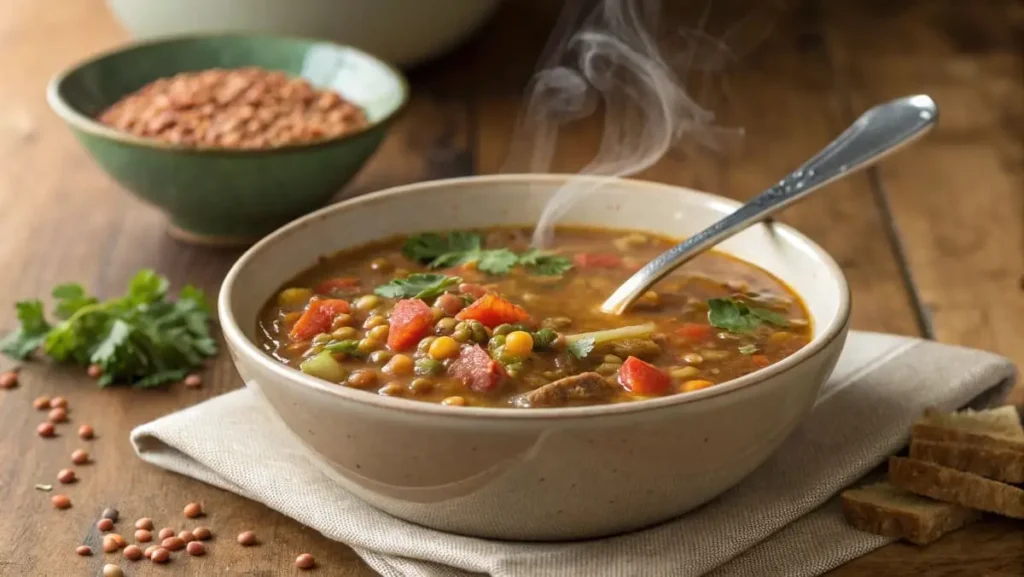
Recipe: Budget-Friendly Lentil Soup
- Yield: 6 servings
- Preparation Time: 15 minutes
- Cooking Time: 45 minutes
- Total Time: 1H
- Portion Size: Approximately 1.5 cups
- Nutritional Value (per serving) Nutritional information is approximate and based on data from the USDA FoodData Central
- Calories: ~250 kcal
- Protein: 15g
- Fat: 5g
- Carbohydrates: 40g
- Fiber: 15g
- Ingredients:
- 1 tablespoon olive oil (15g)
- 1 large onion, chopped (150g)
- 2 carrots, chopped (100g)
- 2 celery stalks, chopped (100g)
- 2 cloves garlic, minced (10g)
- 1 teaspoon dried thyme (2g)
- 1/2 teaspoon dried cumin (1g)
- 1 cup brown or green lentils, rinsed (200g)
- 6 cups vegetable broth (1.5L)
- 1 (14.5 ounces) can of diced tomatoes, undrained (400g)
- 1 bay leaf
- Salt and pepper to taste
- Optional: Lemon wedges, chopped parsley for garnish
- Instructions:
- Heat olive oil in a large pot or Dutch oven over medium heat. Add onion, carrots, and celery and cook until softened about 5-7 minutes.
- Add garlic, thyme, and cumin and cook for 1 minute more, until fragrant.
- Stir in lentils, vegetable broth, diced tomatoes, and bay leaf. Bring to a boil, then reduce heat and simmer for 30-40 minutes, or until lentils are tender.
- Remove the bay leaf. Season with salt and pepper to taste.
- Serve hot, garnished with lemon wedges and parsley if desired.
- Ingredients to be Careful of: Sodium content in canned tomatoes and vegetable broth. Choose low-sodium options if needed.
- Dietary Restrictions: Vegetarian, vegan (if using vegetable broth), gluten-free, dairy-free.
- Chef’s Tip: For a richer flavor, sauté the vegetables in a bit of butter or bacon fat before adding the lentils and broth (if not adhering to vegan/vegetarian or very low-fat diets). You can also add a splash of red wine vinegar at the end for brightness. For a creamier soup, blend a portion of it before serving using an immersion blender.
Quick Chicken & Veggie Stir-Fry (Versatile & Customizable)

Recipe: Budget Chicken Stir-Fry
- Yield: 4 servings
- Preparation Time: 20 minutes
- Cooking Time: 20 minutes
- Total Time: 40 minutes
- Portion Size: Approximately 1.5 cups
- Nutritional Value (per serving, approximate):
- Calories: ~350 kcal
- Protein: 35g
- Fat: 10g
- Carbohydrates: 30g
- Ingredients:
- 1 tablespoon vegetable oil (15g)
- 1 pound boneless, skinless chicken breasts, cut into bite-sized pieces (450g)
- 1 onion, sliced (100g)
- 2 cups mixed vegetables, such as broccoli florets, sliced carrots, bell peppers, snap peas (300g) (use frozen or whatever is on sale/in season)
- 2 cloves garlic, minced (10g)
- 1/4 cup soy sauce (60ml) (low sodium preferred)
- 2 tablespoons honey or brown sugar (30g)
- 1 tablespoon rice vinegar (15ml)
- 1 teaspoon sesame oil (5ml)
- 1/2 teaspoon ground ginger (1g)
- Optional: Cooked rice or noodles for serving, sesame seeds for garnish
- Instructions:
1- Heat vegetable oil in a large skillet or wok over medium-high heat. Add chicken and cook until browned and cooked through. Remove chicken from skillet and set aside.
2- Add onion and mixed vegetables to the skillet and stir-fry for 5-7 minutes, until vegetables are tender-crisp. Add garlic and cook for 1 minute more, until fragrant.
3- In a small bowl, whisk together soy sauce, honey (or brown sugar), rice vinegar, sesame oil, and ginger.
4- Return the chicken to the skillet with the vegetables. Pour sauce over chicken and vegetables and stir-fry for 2-3 minutes, until sauce has thickened and everything is heated through.
5- Serve hot over rice or noodles, garnished with sesame seeds if desired.
- Ingredients to be Careful of: Soy sauce can be high in sodium. Use low-sodium soy sauce or tamari (gluten-free option). Honey/brown sugar adds sweetness; adjust the amount based on preference.
- Dietary Restrictions: Can be made gluten-free by using tamari and gluten-free soy sauce alternatives. Dairy-free.
- Chef’s Tip: Don’t overcrowd the pan when stir-frying. Cook chicken and vegetables in batches if necessary to ensure they brown properly and don’t steam. For extra flavor, marinate the chicken in a little soy sauce and ginger for 30 minutes before cooking. Use cheaper cuts of chicken like thighs, just ensure they are boneless and skinless, and cook them a little longer.
Creamy Tomato Pasta with White Beans (Vegan & Pantry-Friendly)
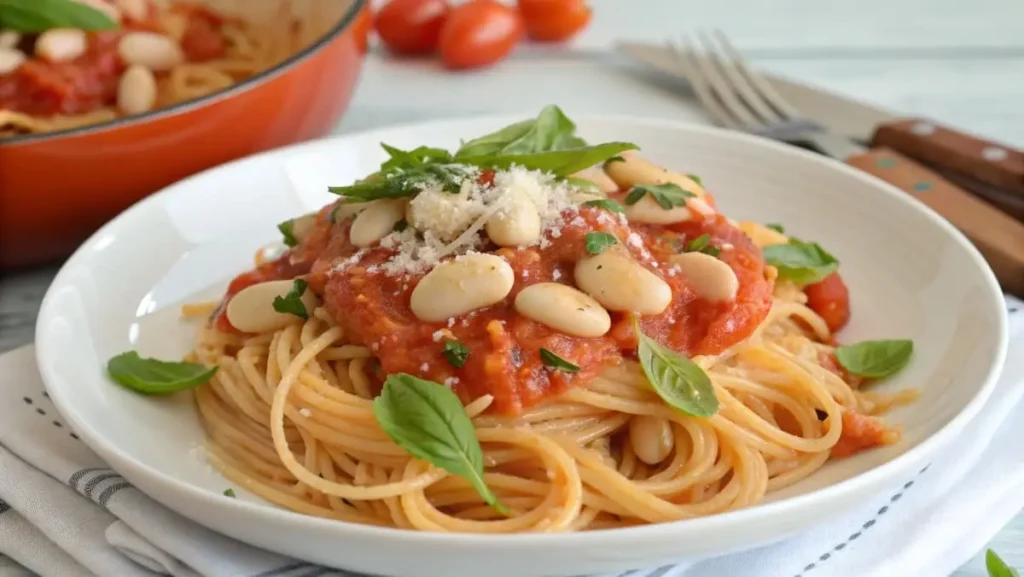
Recipe: Budget Vegan Tomato Pasta
- Yield: 4 servings
- Preparation Time: 10 minutes
- Cooking Time: 25 minutes
- Total Time: 35 minutes
- Portion Size: Approximately 1.5 cups
- Nutritional Value (per serving, approximate):
- Calories: ~400 kcal
- Protein: 15g
- Fat: 8g
- Carbohydrates: 70g
- Fiber: 10g
- Ingredients:
- 1 pound pasta (penne, spaghetti, or your choice) (450g)
- 2 tablespoons olive oil (30g)
- 2 cloves garlic, minced (10g)
- 1 (28 ounces) can of crushed tomatoes (800g)
- 1 (15-ounce) can of white beans, rinsed and drained (400g)
- 1/2 cup vegetable broth or pasta water (120ml)
- 1/4 cup nutritional yeast (20g) (for cheesy flavor – optional but recommended)
- 1 teaspoon dried oregano (2g)
- Salt and pepper to taste
- Optional: Fresh basil for garnish, red pepper flakes for heat
- Instructions:
1- Cook pasta according to package directions until al dente. Reserve about 1/2 cup of pasta water before draining.
2- While pasta is cooking, heat olive oil in a large skillet over medium heat. Add garlic and cook for 1 minute, until fragrant.
3- Add crushed tomatoes, white beans, vegetable broth (or pasta water), nutritional yeast (if using), and oregano to the skillet. Bring to a simmer and cook for 15-20 minutes, stirring occasionally, until sauce has thickened slightly.
4- Season sauce with salt and pepper to taste.
5- Add cooked pasta to the skillet with the sauce and toss to coat. Add a little more pasta water if needed to reach desired consistency.
6- Serve hot, garnished with fresh basil and red pepper flakes if desired.
- Ingredients to be Careful of: Sodium content in canned tomatoes and vegetable broth. Choose low-sodium options if needed.
- Dietary Restrictions: Vegan, vegetarian, dairy-free. Can be made gluten-free by using gluten-free pasta.
- Chef’s Tip: For a richer, creamier sauce, blend half of the white beans with a little of the sauce before adding the pasta. This creates a naturally creamy texture without adding dairy. A pinch of sugar can also balance the acidity of the tomatoes. Use different types of beans like cannellini or Great Northern for varied flavors and textures.
Savory Chickpea Curry (Flavorful & Budget-Conscious)
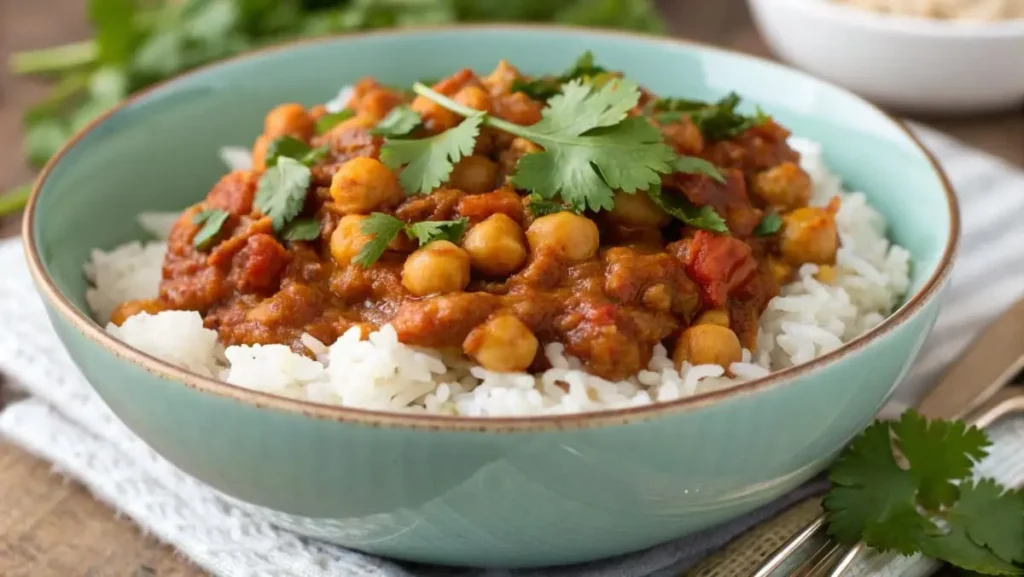
Recipe: Budget Chickpea Curry
- Yield: 4 servings
- Preparation Time: 15 minutes
- Cooking Time: 35 minutes
- Total Time: 50 minutes
- Portion Size: Approximately 1.5 cups curry + 1/2 cup rice
- Nutritional Value (per serving, approximate, without rice):
- Calories: ~300 kcal
- Protein: 12g
- Fat: 15g
- Carbohydrates: 35g
- Fiber: 10g
- Ingredients:
- 1 tablespoon vegetable oil (15g)
- 1 large onion, chopped (150g)
- 2 cloves garlic, minced (10g)
- 1 tablespoon grated ginger (fresh) (10g)
- 1 tablespoon curry powder (adjust to taste) (10g)
- 1 teaspoon ground cumin (2g)
- 1/2 teaspoon turmeric powder (1g)
- 1/4 teaspoon cayenne pepper (optional, for heat) (0.5g)
- 1 (14.5 ounce) can diced tomatoes, undrained (400g)
- 2 (15 ounce) cans chickpeas, rinsed and drained (800g)
- 1 cup vegetable broth or water (240ml)
- 1/2 cup coconut milk (canned, full-fat or light) (120ml)
- Salt to taste
- Cooked rice for serving
- Optional: Fresh cilantro for garnish
- Instructions:
1- Heat vegetable oil in a large pot or Dutch oven over medium heat. Add onion and cook until softened, about 5-7 minutes.
2- Add garlic and ginger and cook for 1 minute more, until fragrant.
3- Stir in curry powder, cumin, turmeric, and cayenne pepper (if using) and cook for 1 minute more, until spices are fragrant.
4- Add diced tomatoes (undrained), chickpeas, and vegetable broth or water. Bring to a simmer, then reduce heat and cook for 20-25 minutes, stirring occasionally, until sauce has thickened slightly.
5- Stir in coconut milk and cook for another 5 minutes. Season with salt to taste.
6- Serve hot over rice, garnished with fresh cilantro if desired.
- Ingredients to be Careful of: Sodium content in canned tomatoes and vegetable broth. Choose low-sodium options if needed. Coconut milk adds richness but also fat; use light coconut milk to reduce fat content.
- Dietary Restrictions: Vegetarian, vegan, gluten-free, dairy-free (if using dairy-free coconut milk alternative).
- Chef’s Tip: For a deeper flavor, toast the spices in a dry pan for a minute or two before adding them to the oil. You can also add vegetables like spinach, potatoes, or cauliflower to the curry for extra nutrients and bulk. If you like a smoother curry, you can blend a portion of the sauce before adding the coconut milk.
Bonus Tips for Budget Diet Success
Want to take your budget diet meals to the next level? Here are some extra tips to help you succeed.
Embrace Seasonal Eating: Freshness for Less
Eating seasonally is like unlocking a secret level in the budget friendly meals game. When fruits and vegetables are in season, they are abundant, which means they are cheaper and taste their absolute best.
- Spring: Asparagus, peas, spinach, strawberries, radishes
- Summer: Tomatoes, zucchini, corn, berries, peaches, cucumbers
- Fall: Apples, pumpkins, squash, sweet potatoes, broccoli, cauliflower
- Winter : Citrus fruits, root vegetables (carrots, potatoes, onions), kale, cabbage
Visit your local farmers’ market to see what’s in season and often find even better deals than in supermarkets.
Cook Once, Eat Twice (or More!): Leftover Magic
Batch cooking and embracing leftovers are key to saving both time and money. Make larger portions of meals and enjoy the leftovers for lunch the next day, or freeze them for future easy budget diet meals. Soups, stews, casseroles, and roasted meats are perfect for batch cooking.
For more inspiration on meal prepping, especially with plant-based meals, check out this guide on plant-based meal prep mastery.
- Repurpose Leftovers: Get creative with leftovers! Roasted chicken can become chicken salad, tacos, or soup. Leftover rice can be turned into fried rice or a rice bowl.
- Proper Storage: Store leftovers in airtight containers in the refrigerator and eat them within 3-4 days. Freeze leftovers for longer storage (up to 2-3 months).
- Reheating Tips: Reheat leftovers thoroughly to ensure food safety. Soups and stews reheat well on the stovetop or in the microwave. Roasted meats and vegetables can be reheated in the oven or air fryer to maintain crispness.
Minimize Food Waste: Use It All Up!
Food waste is throwing money in the trash. Let’s be smarter and more sustainable with our food.
- Vegetable Scrap Broth: Save vegetable scraps like onion peels, carrot tops, and celery in a freezer bag. Simmer them in water to make your vegetable broth when you have enough.
- Proper Produce Storage: Learn how to store different types of produce correctly to extend their shelf life. For example, store potatoes and onions in a cool, dark place, and keep berries in the refrigerator unwashed until you are ready to eat them.
- Freeze, Freeze, Freeze: Freeze leftover bread, fruits that are getting too ripe, and portions of meals. Freezing is your best friend in the fight against food waste.
- “Use-It-Up” Meals: Once a week, plan a meal specifically to use up any leftover ingredients in your fridge and pantry. This could be a frittata, stir-fry, soup, or pasta dish.
Adapting to Dietary Needs on a Budget
Following a specific diet, like gluten-free or dairy-free, might seem more expensive, but it doesn’t have to be. Focus on naturally affordable and suitable ingredients.
- Gluten-Free: Naturally gluten-free grains like rice, quinoa, and oats are budget-friendly. Legumes, fruits, vegetables, and lean proteins are also naturally gluten-free and affordable.
- Dairy-Free: Plant-based milk alternatives can be pricier than cow’s milk, but consider using them only when needed in recipes. For creamy textures, use blended beans, avocados, or nutritional yeast instead of dairy in some dishes.
- Resourcefulness is Key: Look for affordable substitutions for expensive specialty items. For example, instead of pricey gluten-free bread, focus on naturally gluten-free meals like rice bowls or lentil soup.
If you are following a specific diet like keto, budget-friendly meals are still achievable. For example, explore these easy and delicious keto lunch ideas for inspiration.
Conclusion: Your Journey to Thrifty & Delicious Eating
Congratulations! You’re now equipped with the knowledge and recipes to embark on your journey to thrifty and delicious eating. Remember, creating budget friendly diet meals is not about deprivation; it’s about making smart, resourceful choices that benefit both your health and your wallet.
Start with meal planning, embrace pantry staples, and get creative in the kitchen. Experiment with the recipes we’ve shared, and don’t be afraid to adapt them to your tastes and what you have on hand. Healthy eating doesn’t have to be expensive. With a little planning and these helpful tips, you can enjoy delicious, nutritious meals every day without breaking the bank. Happy cooking, and bon appétit!
Frequently Asked Questions (FAQ)
- Q1: What are some examples of budget friendly diet meals I can make?
- Lentil soup, chickpea curry, pasta with white beans and tomato sauce, chicken and vegetable stir-fries, oatmeal with fruit, and egg scrambles with vegetables are all excellent examples of affordable and healthy meals. These meals utilize pantry staples and seasonal produce to keep costs down while maximizing nutrition and flavor.
- Q2: How can I plan budget friendly healthy meals for the week?
- Start by checking store flyers and planning your meals around sale items and seasonal produce. Create a weekly meal plan and a detailed shopping list. Utilize pantry staples and plan for leftovers. Batch cooking components like grains and beans on the weekend can also save time and money during the week.
- Q3: What are the best cheap and healthy ingredients to buy when I’m on a budget?
- Focus on pantry staples like rice, oats, pasta, lentils, beans (dried and canned), canned tomatoes and vegetables, frozen fruits and vegetables, eggs, and seasonal produce. These ingredients are versatile and nutritious, and form the foundation of many affordable and healthy recipes.
- Q4: Is it possible to eat a healthy diet on a tight budget?
- Absolutely! It requires planning, smart shopping, and focusing on whole, unprocessed, and affordable ingredients. By cooking at home, utilizing pantry staples, reducing food waste, and embracing seasonal eating, you can enjoy a healthy and delicious diet even when money is tight. It’s about making informed choices and prioritizing nutritious, budget-friendly options.
Loved making this? Share your experience in a review!
There are no reviews yet. Be the first one to write one.





